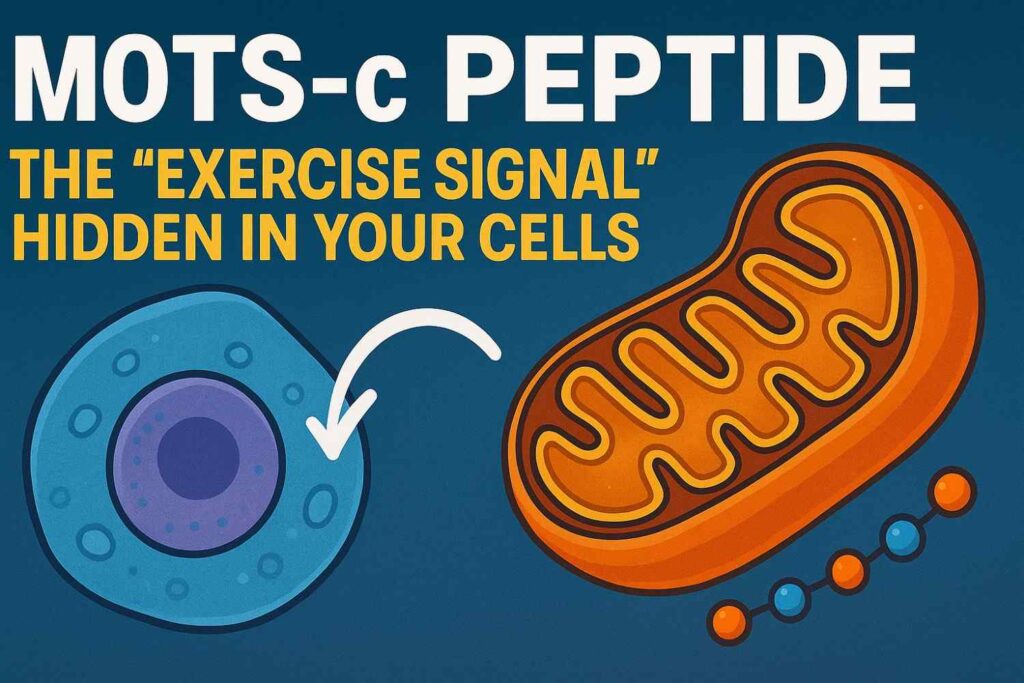
We’ve all heard the phrase “mitochondria are the powerhouse of the cell.” Teachers repeat it in school biology classes, and it sticks. But here’s something most people never hear: mitochondria do more than just make energy.
In 2015, a group of scientists discovered that mitochondria also produce a small peptide messenger called MOTS-c. And this tiny molecule seems to have a big job — helping the body manage energy, handle stress, and maybe even slow down parts of the aging process.
Sounds exciting, right? Let’s dive in.
What Exactly Is MOTS c Peptide ?
MOTS-c (short for Mitochondrial Open Reading Frame of the 12S rRNA-c) is a peptide made of just 16 amino acids. That’s short compared to big proteins, but don’t let its size fool you — it acts like a powerful signal.
The unique thing about MOTS-c is its origin. Most proteins in your body are coded in nuclear DNA (the DNA in your cell’s nucleus). MOTS-c, however, comes from mitochondrial DNA — meaning it’s a direct product of the very structures that fuel your cells.
Think of it like this: when your body faces stress (like exercise, fasting, or metabolic imbalance), mitochondria send out MOTS-c as a “helping hand” message to keep things balanced.
How Does MOTS c Peptide Work?
Scientists are still mapping out all the details, but here’s what we know so far:
- 🟢 Improves energy use → MOTS-c makes it easier for cells to take in glucose (sugar) and use it effectively.
- 🟢 Activates AMPK → This is the same “energy sensor” pathway that gets triggered during workouts or calorie restriction.
- 🟢 Switches on fat burning → When sugar runs low, MOTS-c nudges the body to burn stored fat.
- 🟢 Protects under stress → It helps shield cells from oxidative damage and inflammation.
In simpler words, MOTS-c helps the body act like it’s exercising, even if you’re sitting still.
The Potential Benefits of MOTS-c
Although human research is still in its early days, studies in animals and pilot trials suggest some pretty interesting possibilities.
1. Better Metabolic Health
- Improves insulin sensitivity
- Helps stabilize blood sugar
- Could play a role in managing type 2 diabetes
2. Exercise-Like Effects
- Boosts endurance and stamina in lab studies
- Supports muscle performance
- Some researchers call it a “molecular mimic of exercise”
3. Anti-Aging Potential
- In older mice, MOTS-c helped preserve muscle function and activity levels
- May slow down some age-related metabolic decline
4. Stress & Cell Protection
- Guards cells from oxidative stress
- May calm down low-grade inflammation, a driver of aging
5. Brain & Cognitive Health (Emerging)
- Early lab studies suggest possible benefits for brain energy metabolism
- Could reduce certain types of neuroinflammation
How Does MOTS-c Compare to Other Peptides?
- MOTS-c vs. BPC-157 → BPC-157 is more about healing tissues, gut lining, and injuries, while MOTS-c focuses on metabolism and energy use.
- MOTS-c vs. HGH (Human Growth Hormone) → HGH helps with muscle growth and repair, but MOTS-c is more like a “metabolic thermostat.”
- MOTS-c vs. Exercise → It copies some cellular effects of exercise but can’t replace the full benefits of moving your body.
Is MOTS-c Safe?
Here’s the honest answer: we don’t fully know yet.
- It’s a natural peptide produced by your body.
- So far, animal studies and early human trials suggest it’s well-tolerated.
- But we lack long-term, large-scale clinical studies.
At this point, MOTS-c is not approved by the FDA (or similar health bodies) as a drug or supplement. Some research clinics offer it for experimental use, usually as injections, but it’s still considered investigational.
The Future of MOTS-c
Many scientists are optimistic about where MOTS-c research is heading. Possible future uses include:
- Supporting type 2 diabetes treatment
- Helping with weight management
- Protecting against age-related muscle loss
- Boosting recovery and performance in athletes
- Longevity and “healthy aging” therapies
But remember: these are potential applications, not established treatments.
FAQs About MOTS-c
Not as an approved over-the-counter product. Any sources online are research-grade and not regulated.
It mimics some exercise pathways but doesn’t cover the full benefits — like improved heart health, bone strength, or mental well-being.
In mice, it improved healthspan and delayed some age-related decline. Human data is still too limited to make such claims.
Through subcutaneous injection (under the skin). Oral forms wouldn’t survive digestion.
People with metabolic disorders, older adults facing muscle loss, and possibly athletes — but again, this is still under study.
Final Thoughts
MOTS-c is one of those rare scientific discoveries that makes you rethink what you thought you knew about biology. The idea that mitochondria — the cell’s “power plants” — also send out molecular instructions that affect aging and metabolism is groundbreaking.
We’re still in the early chapters of the MOTS-c story. But if research continues to unfold the way it has so far, this tiny peptide may become a powerful tool for healthier living and longer lifespans.
Disclaimer
This blog is for educational purposes only. MOTS-c is still experimental and not an FDA-approved treatment. Do not attempt to use or buy MOTS-c without medical supervision. Always consult a qualified healthcare professional before considering any new therapy.